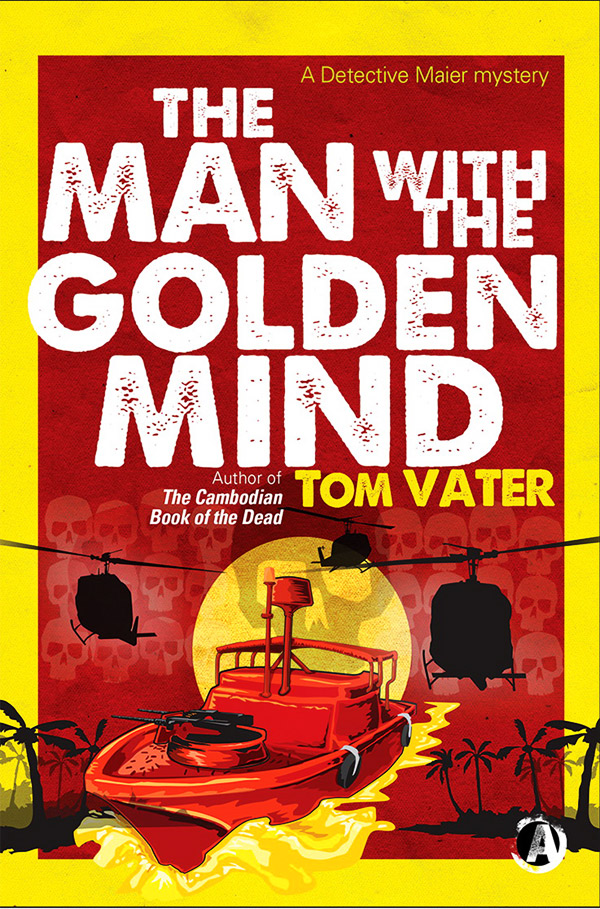
The Man with the Golden Mind, the second Detective Maier Mystery, has its background in one of the great barely reported secret histories of the 20th century – the US secret war in Laos.
From 1965 to 1973, the CIA ran its largest covert operation to date in Laos, a small landlocked Southeast Asian country neighboring China, Vietnam, Cambodia and Thailand. During this time, the American secret service trained a secret army of montagnards (ethnic minorities) to fight the Laotian communists. The secret heart of this operation was an airport called Long Cheng, deep in the Laotian jungles. From here, the US flew aid and ammunition, troops and drugs around the country. For some years, Long Cheng was the country’s second largest city and the world’s busiest airport, though few people knew of its existence. As the war in Vietnam was being lost in the late 1960s, the US Air Force took over from the CIA mission and bombed the country back into the stone-age. Up to half a million people perished in the bombing, which was heavier than all the tonnage dropped during World War 2.
I first heard of Long Cheng in 2000 when I traveled across the Plain of Jars, a vast highland in northeastern Laos covered in bomb craters and unexploded ordnance, with my wife, photographer Aroon Thaewchatturat and my brother, film maker Marc Eberle. Here, entire villages were built from US war scrap and people lost lives and limbs to buried bombs at an alarming rate, 25 years after the war had ended. We were told that no journalists had been to the secret airport since the end of the war in 1975. We were hooked on the story of “The Most Secret Place on Earth”.
It took some five years to make the feature documentary about Long Cheng’s rise and fall and the story of the CIA’s covert war in Laos. During the research for the film, which my brother directed and for which we wrote the screenplay together, we met former CIA case officers and burocrats, Air America pilots, Thai mercenaries, academics, the Hmong (montagnard) general who ran the CIA’s secret army and the whistleblower who uncovered the secret of the US bombing of Laos. We visited archives in the US and trawled through 1000s of photos, films and documents, returned to Laos and crisscrossed Thailand to interview countless people who played a part in the secret war.
The film was released in 2008, has shown at many film festivals and has been on TV in some thirty countries. The ABC Australia TV version (https://www.youtube.com/watch?v=i8cIki7awN8) is on youtube. My long involvement with this exquisite slice of secret 20th century history gave me the historical background for The Man with the Golden Mind (http://exhibitabooks.com/books/the-man-with-the-golden-mind-by-tom-vater/).
The second Detective Maier Mystery (following last year’s The Cambodian Book of the Dead (http://exhibitabooks.com/books/the-cambodian-book-of-the-dead-by-tom-vater/)) finds the former war correspondent turned PI in Laos, trying to solve the 25 year old murder of a former East German cultural attaché whose daughter, his client, has been kidnapped from under his nose in Hamburg. Maier soon realizes that there’s more to the murder than old politics – gold and a top secret file crammed with Cold War secrets come into play. It is the creator of this file though, a man called Weltmeister, a former US assassin no one has seen in a quarter century, who is the target of a search by the US government, montagnards, the Vietnamese secret service, a young journalist called Kanitha and of course, the detective. The trail leads deep into the Laotian jungles to a tattoo cult and a Vietnamese prison, across the Plain of Jars and finally to America’s most secret base, Long Cheng. I don’t want to provide any spoilers but it gets very personal for Maier this time around.
The Man with the Golden Mind is a more straightforward book than The Cambodian Book of the Dead which had genocide as its central theme, dictating a rather somber tone on the narrative.
The follow-up is lighter, the history is more digestible, though still very much n the dark side of human affairs, and the characters are just as larger than life as in the first Maier Mystery. The novel is a reflection on how secret wars are thought as well as a meditation on family relationships. And least I forget, there are assassinations, mock executions, salacious sex, high quality drugs, sacred tattoos, serious combat and an appearance by the most infamous of US foreign secretaries to keep even the most jaded reader from slipping away.